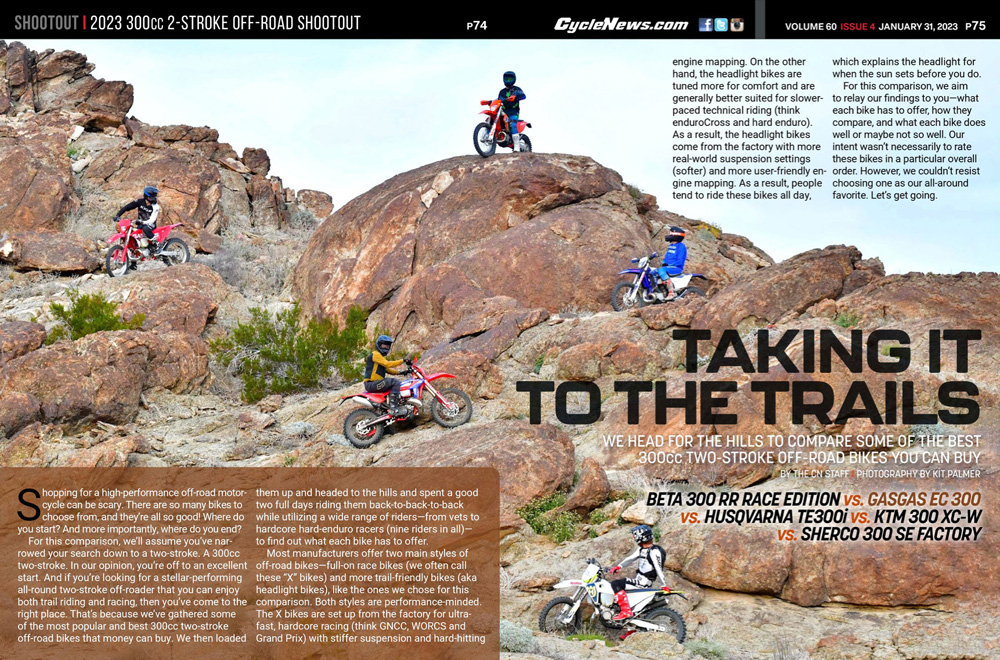Cycle News Staff | February 2, 2023
We head for the hills to compare some of the best 300cc two-stroke off-road bikes you can buy.
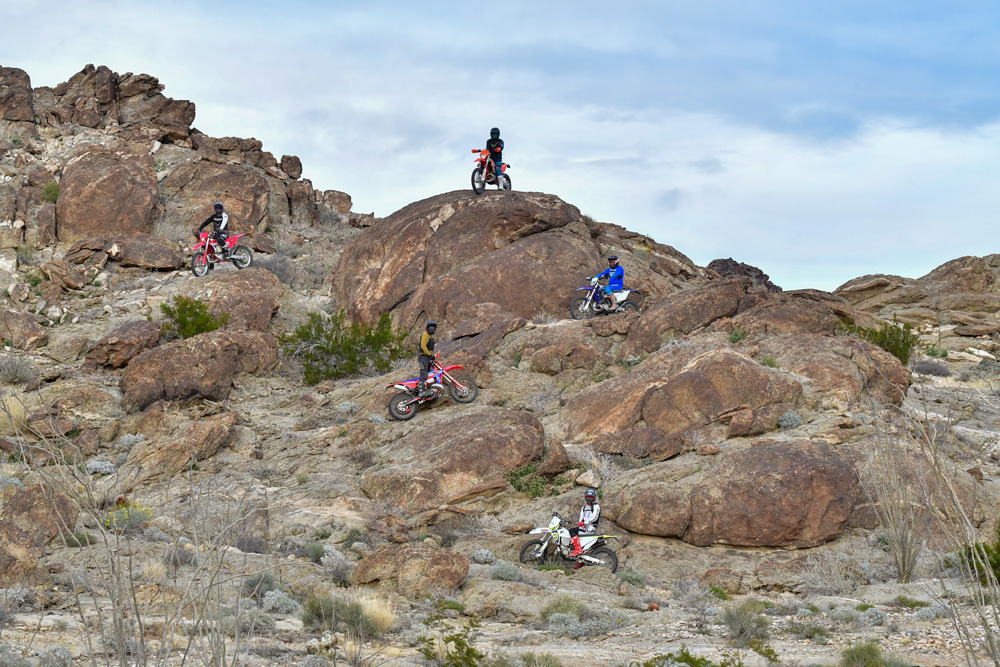
Photography by Kit Palmer
Beta 300 RR Race Edition vs. GasGas EC 300 vs. Husqvarna TE300i vs. KTM 300 XC-W vs. Sherco 300 SE Factory
Shopping for a high-performance off-road motorcycle can be scary. There are so many bikes to choose from, and they’re all so good! Where do you start? And more importantly, where do you end?
For this comparison, we’ll assume you’ve narrowed your search down to a two-stroke. A 300cc two-stroke. In our opinion, you’re off to an excellent start. And if you’re looking for a stellar-performing all-round two-stroke off-roader that you can enjoy both trail riding and racing, then you’ve come to the right place. That’s because we’ve gathered some of the most popular and best 300cc two-stroke off-road bikes that money can buy. We then loaded them up and headed to the hills and spent a good two full days riding them back-to-back-to-back while utilizing a wide range of riders—from vets to hardcore hard-enduro racers (nine riders in all)—to find out what each bike has to offer.
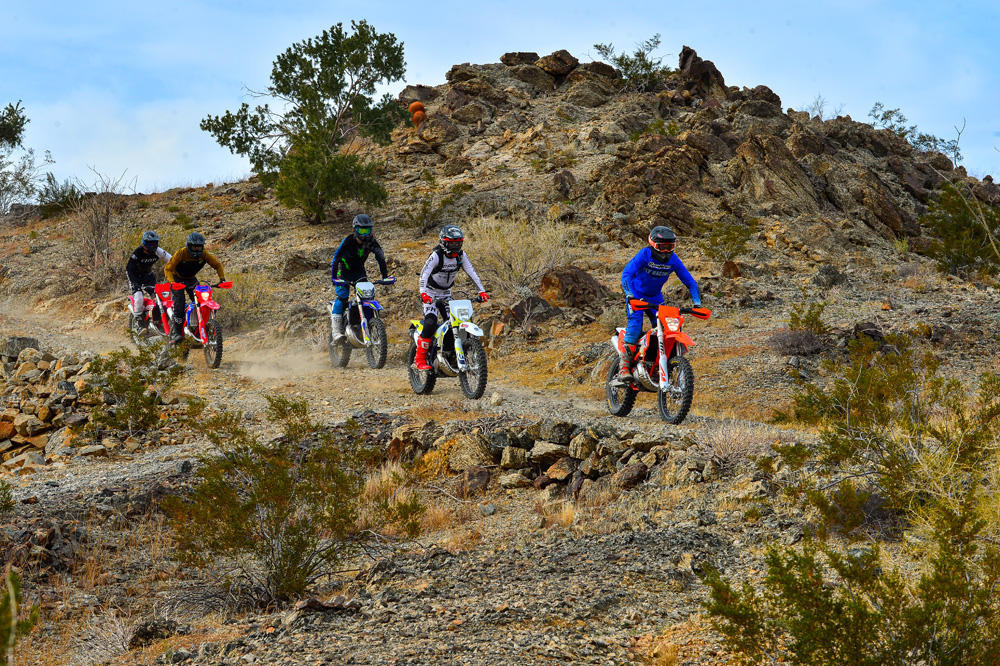
Most manufacturers offer two main styles of off-road bikes—full-on race bikes (we often call these “X” bikes) and more trail-friendly bikes (aka headlight bikes), like the ones we chose for this comparison. Both styles are performance-minded. The X bikes are set up from the factory for ultra-fast, hardcore racing (think GNCC, WORCS and Grand Prix) with stiffer suspension and hard-hitting engine mapping. On the other hand, the headlight bikes are tuned more for comfort and are generally better suited for slower-paced technical riding (think endurocross and hard enduro). As a result, the headlight bikes come from the factory with more real-world suspension settings (softer) and more user-friendly engine mapping. As a result, people tend to ride these bikes all day, which explains the headlight for when the sun sets before you do.
For this comparison, we aim to relay our findings to you—what each bike has to offer, how they compare, and what each bike does well or maybe not so well. Our intent wasn’t necessarily to rate these bikes in a particular overall order. However, we couldn’t resist choosing one as our all-around favorite. Let’s get going.
A Quick Briefing
Beta 300 RR Race Edition
MSRP: $10,399
Weight (measured, wet): 245 lbs.
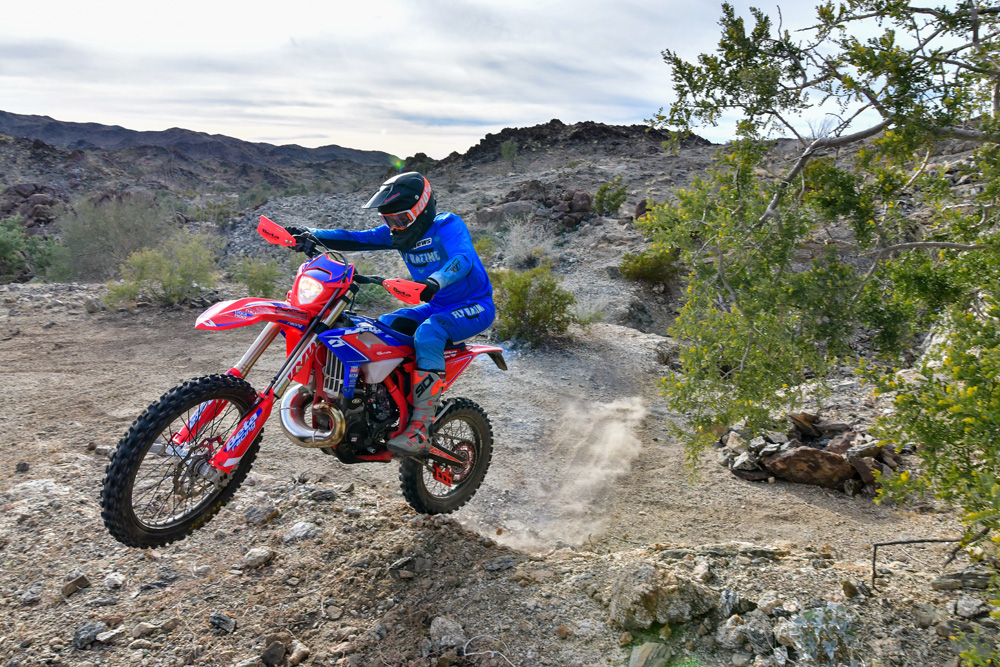 Of all the “headlight bikes,” the Beta 300 RR Race Edition is indeed the most raceable right out of the crate. Updated suspension and a spicy motor made our race-enthusiast testers happy.
Of all the “headlight bikes,” the Beta 300 RR Race Edition is indeed the most raceable right out of the crate. Updated suspension and a spicy motor made our race-enthusiast testers happy.
Beta offers two 300cc two-stroke off-roaders, the RR and RR Race Edition. They are very similar motorcycles. The main differences between the two that you’ll care most about are the Race Edition’s higher-grade KYB suspension package versus the RR’s Sachs components and the Race Edition’s lubrication system, premix versus the RR’s oil-injection system.
The Race Edition also has slightly different cylinder porting, a different cylinder head, and more “bling” parts.
Both RR and Race Edition models fall into the headlight category. We chose the Race Edition for this comparison because we believe most of you will opt for the higher-end Race Edition over the standard RR despite the $500 price difference. You get a lot for that extra $500, mainly superior suspension. For another $300, you can have your Race Edition fitted with oil injection, which is something we’d do in a heartbeat. Yes, it might add some weight, but we’re okay with that.
The Beta 300 RR and RR Race Edition are both carbureted.
The Beta is the only bike in this comparison with a Nissin front brake; the rest come with either Brembo or BrakTec.
Betas are built in Italy and have been available in the U.S. for many years now. It’s a popular European brand with several World Enduro and European off-road titles on its resume. It’s not a fledgling company by any means anymore.
2023 Beta 300 RR Race Edition Specifications
| MSRP: |
$10,399 |
| Engine Type: |
2-stroke, single |
| Displacement: |
292.6cc |
| Bore: |
73mm |
| Stroke: |
69.9mm |
| Starting System: |
Electric |
| Fuel Delivery: |
Keihin PXK 36mm |
| Lubrication: |
Premix |
| Transmission: |
6-speed |
| Clutch: |
Wet, multi-disc diaphragm style, Brembo hydraulic |
| Frame: |
Central double-cradle-type, steel |
| Rear Suspension: |
KYB w/ linkage, fully adj. |
| Front Suspension: |
48mm KYB AOS closed cartridge fully adj. |
| Front-Wheel Travel: |
11.8 in. |
| Rear-Wheel Travel: |
12.4 in. |
| Front Brake: |
260mm Nissin |
| Rear Brake: |
240mm |
| Ground Clearance: |
12.6 in. |
| Seat Height: |
36.6 in. |
| Wheelbase: |
58.3 in. |
| Fuel Tank Capacity: |
2.5 gal. |
| Weight (Measured, Wet): |
245 lbs. |
GasGas EC 300
MSRP: $10,399
Weight (measured, wet): 249 lbs.
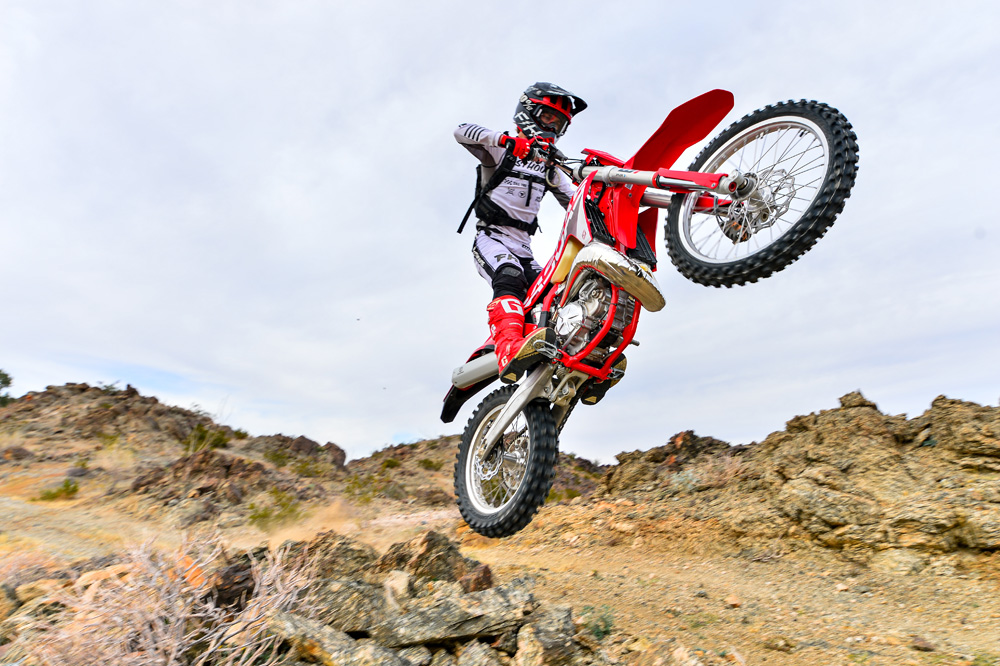 The GasGas doesn’t get all the bells and whistles compared to the other bikes, but it still performs right with them.
The GasGas doesn’t get all the bells and whistles compared to the other bikes, but it still performs right with them.
The GasGas EC 300 is a member of the Austrian family, which includes the Husqvarna TE 300 and KTM 300 XC-W. Of the three bikes, the GasGas is the most budget-friendly. At $10,399, the GasGas comes in $900 less than the midrange Husqvarna and $1950 less than the premium KTM. As a result, you don’t get all the bells and whistles with the GasGas. In reality, however, you still get what you need despite the lower cost, but you’ll have to purchase your own hand guards, skid plate, and a few other things that come stock on the other bikes.
The GasGas shares the same chassis and engine platform as the KTM and Husky. This means that, among other things, the GasGas uses Transfer Port Injection (TPI) technology, which shouldn’t be confused with the new throttle body injection system which just came out on KTM’s 2023 250cc and 300cc SX and XC two-strokes. The GasGas uses a different (lighter) flywheel than the KTM and Husqvarna.
Like the KTM and Husky, the GasGas is oil injected.
All three bikes are fitted with Neken tapered aluminum handlebars but with unique bends, and the GasGas shares the same BrakTec front-brake system as the Husky. (The KTM uses Brembo.)
2023 GasGas EC 300 Specifications
| MSRP: |
$10,399 |
| Engine Type: |
2-stroke, single |
| Displacement: |
293.2cc |
| Bore: |
72mm |
| Stroke: |
72mm |
| Starting System: |
Electric |
| Fuel Delivery: |
TPI |
| Lubrication: |
Oil injection |
| Transmission: |
6-speed |
| Clutch: |
Wet, DDT multi-disc, Braketec hydraulic |
| Frame: |
Central double-cradle-type steel |
| Rear Suspension: |
WP w/ linkage, fully adj. |
| Front Suspension: |
48mm WP Xplor spring fork fully adj. |
| Front-Wheel Travel: |
11.8 in. |
| Rear-Wheel Travel: |
11.8 in. |
| Front Brake: |
260mm BrakTec |
| Rear Brake: |
220mm |
| Ground Clearance: |
14.2 in. |
| Seat Height: |
37.4 in. |
| Wheelbase: |
58.5 in. |
| Fuel Tank Capacity: |
2.25 gal. |
| Weight (Measured, wet): |
249 lbs. |
Husqvarna TE 300i
MSRP: $11,299
Weight (measured, wet): 245 lbs.
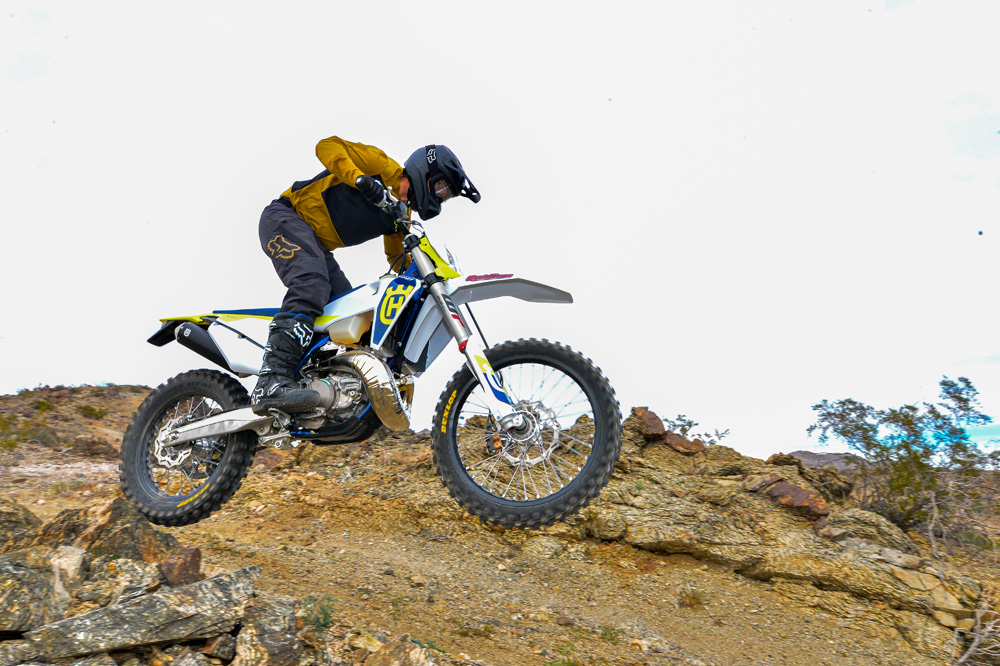 There isn’t much not to like about the Husqvarna TE 300, but the high handlebars got a thumbs down from most of our testers. Our taller riders, however, gave it a thumbs up.
There isn’t much not to like about the Husqvarna TE 300, but the high handlebars got a thumbs down from most of our testers. Our taller riders, however, gave it a thumbs up.
The main thing that sets the Husqvarna TE 300 apart from its GasGas and KTM cousins is its composite carbon fiber subframe versus the others’ aluminum. The Beta and Sherco also use aluminum-constructed subframes. The composite subframe design has been a Husky trademark for several years now. The Husky’s airbox is a little different, too.
Like the Beta and Sherco, you can alter the Husky’s ignition engine mapping via a two-way switch mounted to the left handlebar. (The Beta’s is positioned in front of the fuel tank.)
The Husky comes fitted with a 48mm fully adjustable WP Xplor fork and a WP Xact shock, as do the other two Austrian bikes. The Husky also comes with hand guards and a skid plate, even though our test bike was delivered without hand guards. Don’t worry; yours will have ’em.
2023 Husqvarna TE 300i Specifications
| MSRP: |
$11,299 |
| Engine Type: |
2-stroke, single |
| Displacement: |
293.2cc |
| Bore: |
72mm |
| Stroke: |
72mm |
| Starting System: |
Electric |
| Fuel Delivery: |
TPI |
| Lubrication: |
Oil injection |
| Transmission: |
6-speed |
| Clutch: |
Wet, DDT multi-disc, Braketec hydraulic |
| Frame: |
Central double-cradle-type steel |
| Rear Suspension: |
WP w/ linkage |
| Front Suspension: |
48mm WP Xplor spring fork fully adj. |
| Front-Wheel Travel: |
11.8 in. |
| Rear-Wheel Travel: |
11.8 in. |
| Front Brake: |
260mm BrakTec |
| Rear Brake: |
220mm |
| Ground Clearance: |
14.2 in. |
| Seat Height: |
37.4 in. |
| Wheelbase: |
58.5 in. |
| Fuel Tank Capacity: |
2.25 gal. |
| Weight (Measured, wet): |
245 lbs. |
KTM 300 XC-W
MSRP: $12,349
Weight (measured, wet): 243 lbs.
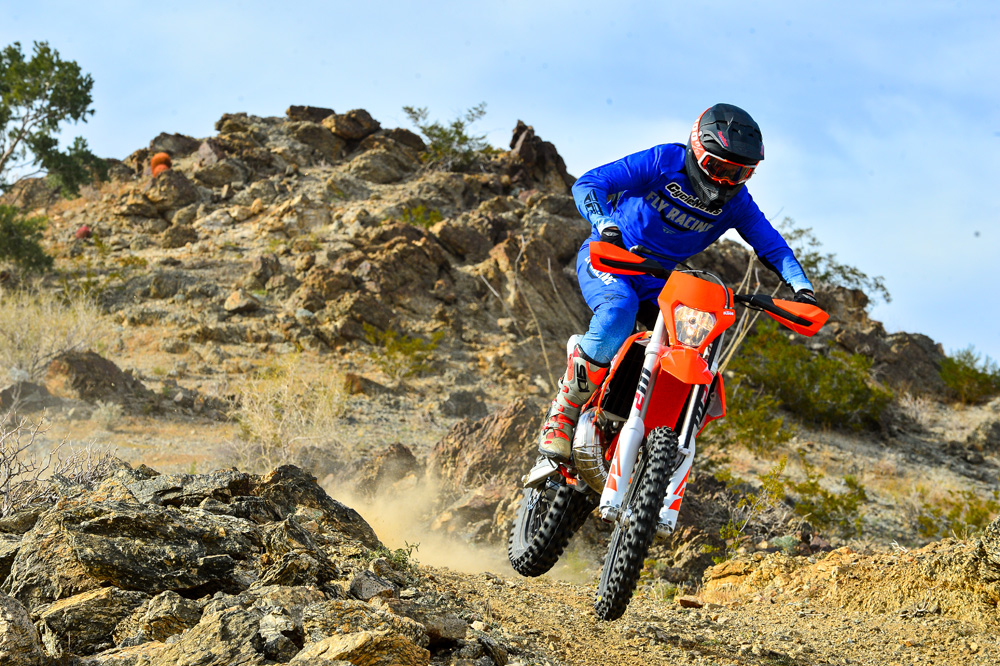 Race it or trail it, the KTM will oblige.
Race it or trail it, the KTM will oblige.
Since the beginning of time, it seems, KTM’s 300cc two-stroke off-road engine has been the engine by which all other 300cc two-strokes are judged—and pretty much the entire KTM 300 motorcycle, for that matter. If you’ve ever ridden one, you understand.
Compared to the GasGas and Husky, the KTM 300 XC-W also rides on WP suspension components, uses TPI fueling technology and is oil-injected. Unlike the Husky, the KTM is not fitted with an adjustable engine map switch. Strange. However, a secondary map is preprogrammed in the ECU, but to access it, you must purchase KTM’s optional handlebar-mounted switch.
What sets the KTM apart from its GasGas and Husqvarna cousins and the other four bikes in this comparison is its rear suspension system. It’s the only bike whose shock does not ride on linkage; instead, it’s bolted right to the swingarm. KTM calls this design PDS for Progressive Damping System, which has been around since 1997. With PDS, the shock progressively increases damping through the stroke via an inner needle and dual pistons. For the off-road rider, PDS has several advantages: the design is simple, maintenance is low (no moving parts to grease, and the shock is easy to replace in a pinch), it’s lighter than a linkage system, and offers more ground clearance, which is excellent for bashing over logs, rocks and even K-rails. There are tradeoffs, however. Mainly, some off-roaders feel the linkage KTMs, like the 300 XC (without the “W”), have a plusher and more sensitive feel.
Other things to think about, the KTM is the lightest of the five and costs the most.
2023 KTM 300 XC-W Specifications
| MSRP: |
$12,349 |
| Engine Type: |
2-stroke, single |
| Displacement: |
293.1cc |
| Bore: |
72mm |
| Stroke: |
72mm |
| Starting System: |
Electric |
| Fuel Delivery: |
TPI |
| Lubrication: |
Oil injection |
| Transmission: |
6-speed |
| Clutch: |
Wet, DDT multi-disc, Magura hydraulic |
| Frame: |
Central double-cradle-type steel |
| Rear Suspension: |
WP w/ PDS, fully adj. |
| Front Suspension: |
48mm WP Xplor spring fork, fully adj. |
| Front-Wheel Travel: |
11.8 in. |
| Rear-Wheel Travel: |
12.2 in. |
| Front Brake: |
260mm Brembo |
| Rear Brake: |
220mm |
| Ground Clearance: |
14.2 in. |
| Seat Height: |
37.7 in. |
| Wheelbase: |
58.5 in. |
| Fuel Tank Capacity: |
2.4 gal. |
| Weight (Measured, wet): |
243 lbs. |
Sherco 300 SE Factory
MSRP: $11,849
Weight (measured, wet): 255 lbs.
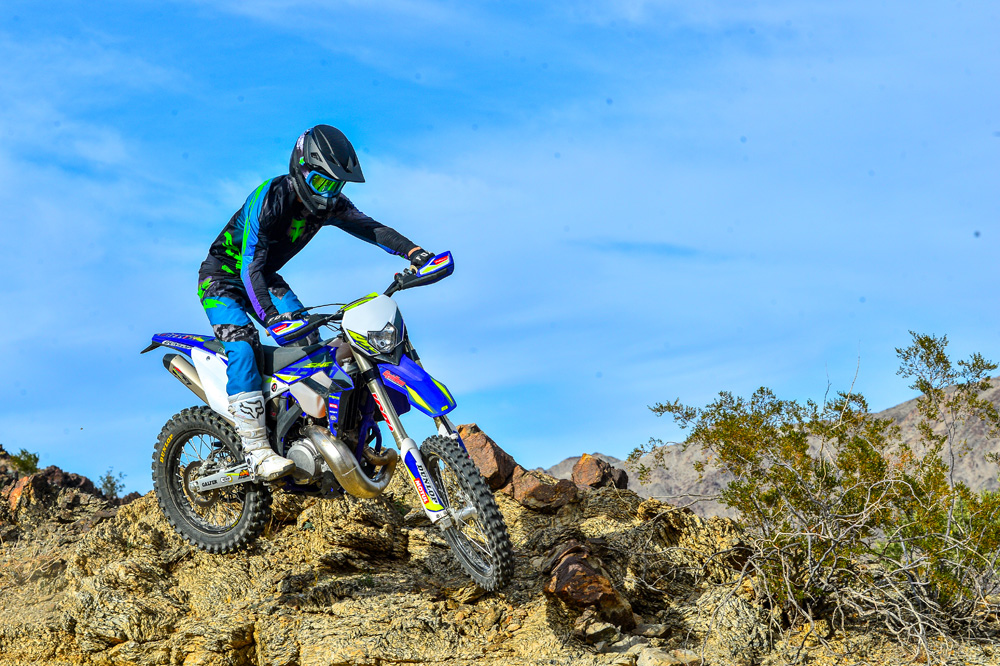 The Sherco is built for battle with its heavy-duty skid plate, stout handguards and radiator fan for when things get toasty.
The Sherco is built for battle with its heavy-duty skid plate, stout handguards and radiator fan for when things get toasty.
Shercos are built in France, are well-known in Europe, and have several major hard enduro race wins, including the granddaddy of them all, Erzberg. However, Sherco is a relatively new brand in the U.S., but the name is gaining traction here quickly, especially after the signing (and recent re-signing) of former EnduroCross and SuperEnduro World Champion Cody Webb and young rising star Cooper Abbott (yes, Destry’s son).
Like the Beta, the Sherco 300 SE Factory is carbureted. However, the Sherco is the only bike in this comparison that utilizes an electronic exhaust power valve; the others are mechanical. This means that when you change the Sherco’s mapping from the handlebar switch, you are also changing the power valve. To adjust the power valves on the other bikes, you must stop and use a tool.
The Sherco is also the only bike with a built-in radiator fan. It also comes with several quality parts, including Neken handlebars, KYB suspension components, a Selle Dalla Valle seat, a Brembo front brake, and a deluxe AXP heavy-duty skid plate. The bike comes with hand guards, and it has the highest-capacity fuel tank of the group at 2.75 gallons. It’s also the heaviest in this comparison at 255 pounds but keep in mind you’re also getting a radiator fan, a heavy-duty skid plate and a larger-capacity fuel tank.
2023 Sherco 300 SE Factory Specifications
| MSRP: |
$11,849 |
| Engine Type: |
2-stroke, single |
| Displacement: |
293.1cc |
| Bore: |
72mm |
| Stroke: |
72mm |
| Starting System: |
Electric |
| Fuel Delivery: |
Keihin PWK 36 |
| Lubrication: |
Premix |
| Transmission: |
6-speed |
| Clutch: |
Wet, multi-disc hydraulic |
| Frame: |
Semi-perimeter, steel |
| Rear Suspension: |
KYB 50, fully adj. |
| Front Suspension: |
KYB closed cartridge 48mm, fully adj. |
| Front-Wheel Travel: |
11.8 in. |
| Rear-Wheel Travel: |
13.0 in. |
| Front Brake: |
260mm Brembo |
| Rear Brake: |
220mm |
| Ground Clearance: |
19.9 in. |
| Seat Height: |
37.4 in. |
| Wheelbase: |
58.27 in. |
| Fuel Tank Capacity: |
2.75 gal. |
| Weight (Measured, wet): |
255 lbs. |
2023 300cc 2-Stroke Off-Road Shootout
Trail Time
Most Fun To Ride?
The term “fun factor” came up often during our testing, and the bike that usually initiated this conversation was the Beta. Its “peppy” motor, outstanding suspension and slim profile were the likely causes.
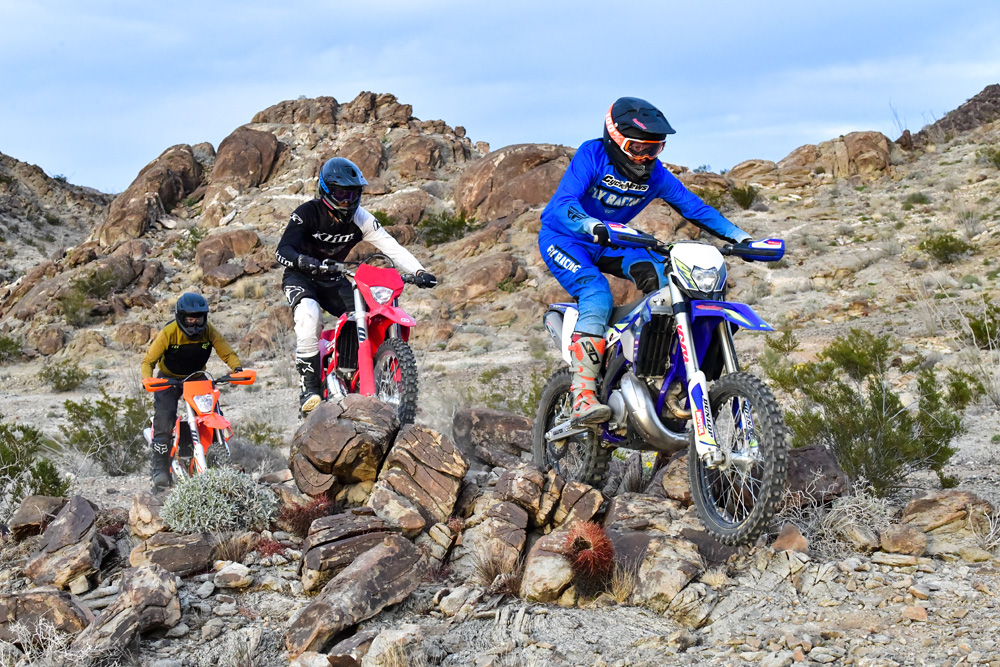 All of the bikes in this comparison have engine counter-balancers, hydraulic clutches and electric starting.
All of the bikes in this comparison have engine counter-balancers, hydraulic clutches and electric starting.
As for the motor, one tester described it as producing “power like a muscle car with chunky torque down low and a midrange-rip that begs to be opened up.” Sounds like the description of a motocross-style engine, and that is how more than one of our testers described it. Yet, despite that “moto-ee” feel the Beta delivers, its motor works exceptionally well at slow or high speeds and is very manageable over various terrain, making it an excellent off-road bike. It adapts to pretty much anything.
Yes, the word “fun” was used often when our testers talked about the Beta. When it gets down to it, however, none of these bikes aren’t fun to ride; hell no, it’s just that the Beta is the most fun. But not by much.
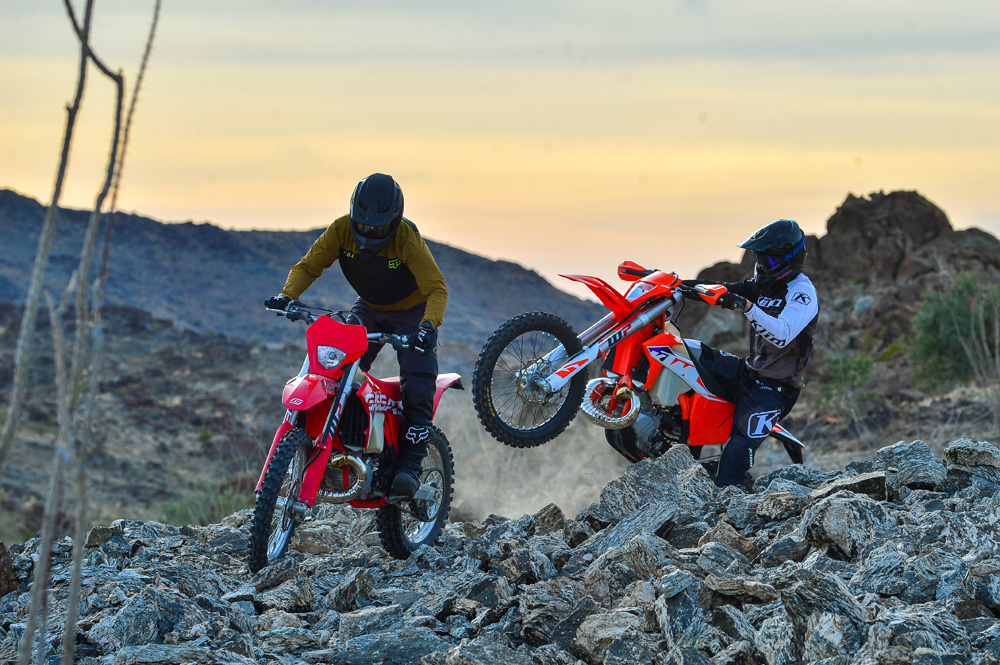 The “headlight” bikes in this comparison are tuned for slow-speed technical riding, so they tend to have softer suspensions than their higher-speed-tuned (GNCC) race cousins, which are often dubbed “X” bikes (without headlights).
The “headlight” bikes in this comparison are tuned for slow-speed technical riding, so they tend to have softer suspensions than their higher-speed-tuned (GNCC) race cousins, which are often dubbed “X” bikes (without headlights).
Which Bike For Tennessee Knockout?
For hardcore racing, with a high emphasis on slower-speed hard enduros or endurocross-type racing, all are totally acceptable, without question, but a couple of bikes stand out. The Sherco, for one, got a lot of praise for its highly useable bottom-end power and excellent first-gear crawlability (although the overall stock gearing is a bit tall). It also makes boatloads of power overall, and its mapping switch is convenient when the terrain changes. You can feel the difference from one map to the other, more so than the other bikes (Husky and Beta) with map switches.
It’s also reassuring when aboard the Sherco that it has such a sturdy skid plate under it and isn’t about to turn into Ol’ Faithful, thanks to its radiator cooling fan. These two things are absolute musts for hardcore extreme-type riding, even if they do add a little weight. The Sherco is hard to fault when it comes to the gnarly stuff. Makes sense because Sherco’s roots run deep in trials.
The KTM also ranks high on almost everyone’s list when it comes to extreme riding. The KTM feels light and maneuverable, and not having rear suspension linkage hanging down and acting like a tailhook on logs, rocks and especially K-rails is especially nice.
The GasGas gets high marks in the technical stuff, as well. Unfortunately for the GasGas, no one had good things to say about its brakes, which doesn’t inspire as much confidence as the KTM or Sherco’s Brembos or the Beta’s Nissins. The GasGas and Husky are fitted with the same BrakTec components, though, for whatever reason, the Husky’s has better bite.
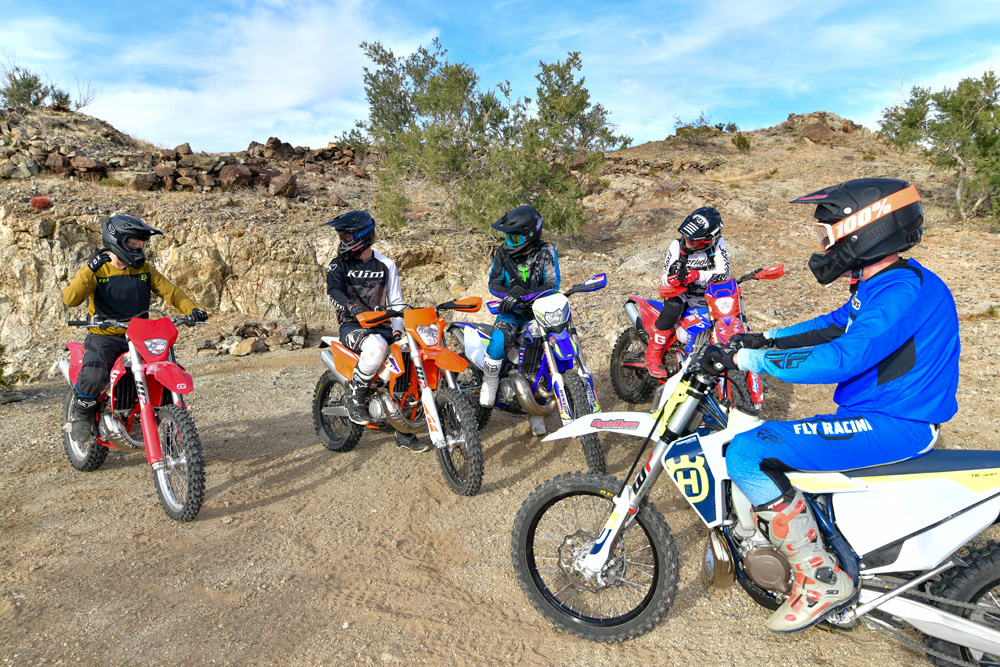 Trading notes.
Trading notes.
Weekend Warrior
If racing is low on your list of things to do but hitting the trails for fun on the weekends is way up there, this one is simple: all these bikes are outstanding for casual and spirited off-road riding. You can’t go wrong with any of them. Eeny-Meeny-Miny-Moe will work just fine if it gets down to it. But there are things to consider, of course, like price, your local dealerships, parts availability, and which bike you think will look best and inspire you the most sitting in your garage. These are all real factors to consider and require your own investigation.
Regarding engine performance, though, there are noticeable differences, mainly with fueling. The TPI (fuel injected) bikes—KTM, Husqvarna, and GasGas—have a unique feel compared to the carbureted bikes (Beta and Sherco). The TPI bikes offer plenty of power, no question there, but deliver that power in an ultra-linear, almost docile manner compared to the carbureted Beta and Sherco. Some people like that, and some don’t. Racers tend not to, while trail riders are more tolerant. The Beta and Sherco motors are more explosive and harder hitting (read: fun) than the TPI bikes no matter what map mode you’re in, while the TPI bikes are more manageable and user-friendly. Choose your weapon. Our testers generally like the feel of the carbureted bikes better for trail riding and racing. But not all. At least one of our testers highly enjoys the feel of the TPI bikes for trail riding. Compared to its Austrian siblings, the GasGas feels the most “snappy,” which makes sense because it has a lighter flywheel.
For some, though, a significant benefit of the fuel injected (TPI) bikes is not having to premix fuel because these bikes are oil injected. We prefer this for weekend/camping trail riding, so major bonus points here go to the KTM, Husky, and GasGas.
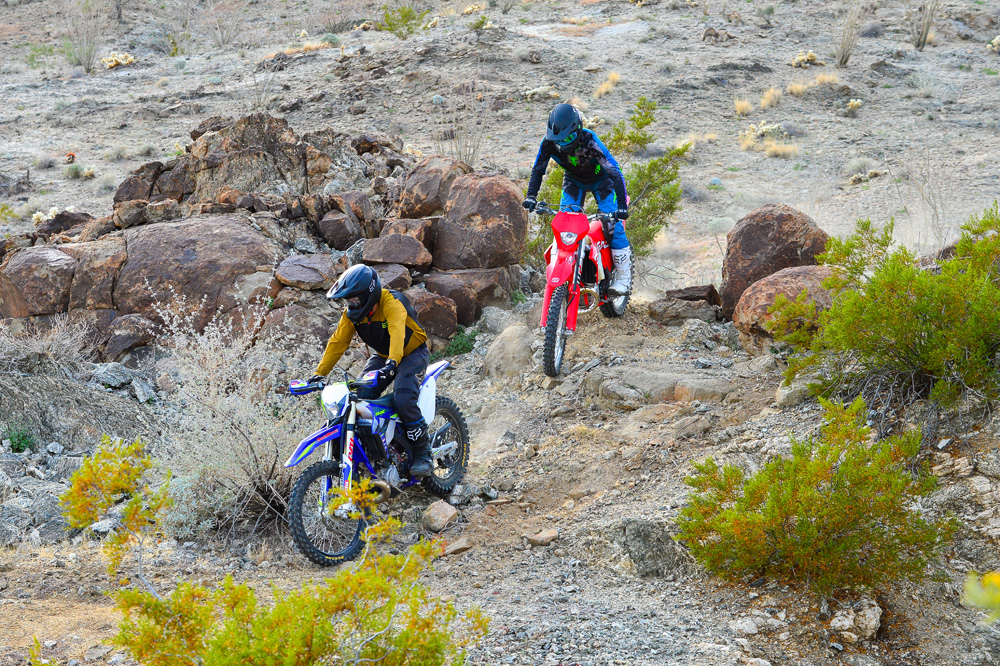 None of the bikes stall easily; they are all tractors.
None of the bikes stall easily; they are all tractors.
For some, though, a significant benefit of the fuel injected (TPI) bikes is not having to premix fuel because these bikes are oil injected. We prefer this for weekend/camping trail riding, so major bonus points here go to the KTM, Husky, and GasGas.
All five bikes are excellent slow-speed rock crawlers and behave well at speed, too, except, perhaps, for one—the Sherco, at least comparatively. Multiple testers said it didn’t feel as planted or stable at speed as the others. And most agreed that its suspension is a little on the harsh side overall and just wasn’t as confidence-inspiring in sixth gear compared to the others. It probably shouldn’t be your first choice for wide-open desert riding.
All five bikes are fitted with odometers and over-size (compared to motocross bikes) translucent fuel tanks, but the Sherco holds the most fuel at 2.75 gallons, which also explains some of its heavier weight compared to the others on our scale. (We weigh our test bikes with full tanks.) The Husky and GasGas contain the least amount at 2.25 gallons. The Sherco’s larger fuel tank, however, didn’t translate to more miles, so we concluded that it’s not as fuel efficient as the others.
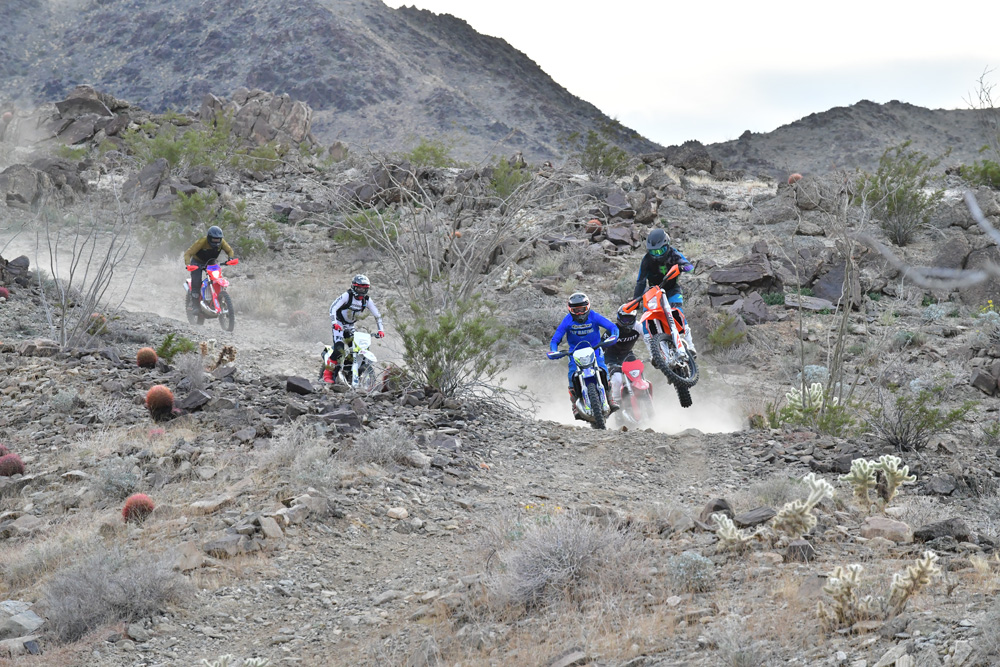 This was about as wide-open as we got during our testing. You should’ve seen the trails that we didn’t take our cameras on!
This was about as wide-open as we got during our testing. You should’ve seen the trails that we didn’t take our cameras on!
One Size Fits All?
Sort of. All five bikes feel similar in the seat but have their own distinct feel. Which bike feels best? That’s impossible to say. Everyone is different. But since none of these bikes come fitted with ape-hangers or anything outlandish like that, they all feel in the ballpark in terms of ergos and comfort.
Even though the Husky, KTM, and GasGas share the same chassis platform, they all feel slightly different. Our test riders commented on the Husky’s high handlebars, as they did the GasGas’ low handlebars, giving these two bikes a distinctively different feel. The KTM’s bars are somewhere in the middle or “just right.”
Some of our testers say the Sherco is a little cramped, while others have no issues. The Beta, says one tester, feels like a motocrosser because of its noticeably slim profile (and barky motor, of course).
The bottom line, they all are comfortable with their own personalities and are easy to adapt to, but the KTM is perhaps the most “neutral” of the group.
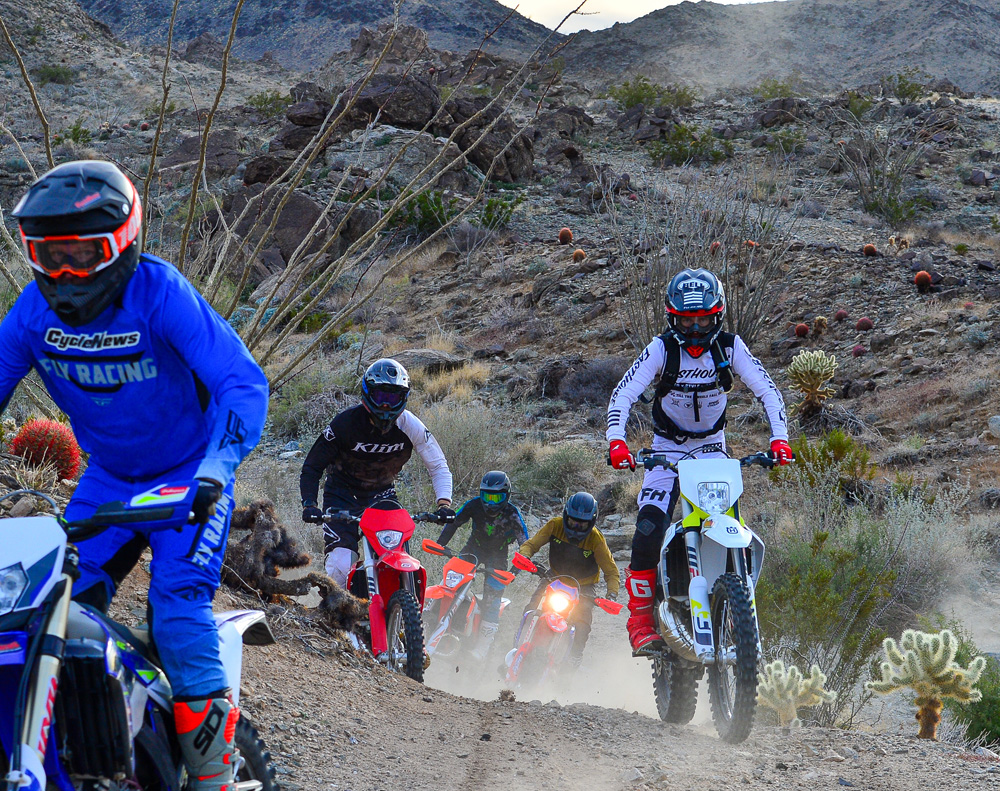
Best Bike All-Around?
We did ask our testers to rate the bikes, and as we expected, the positionings were all over the place, which proves just how evenly matched these bikes are. Three different bikes took top honors among all our testers: the KTM, GasGas and Beta. But the one bike that was at least near or at the top of everyone’s list was the KTM.
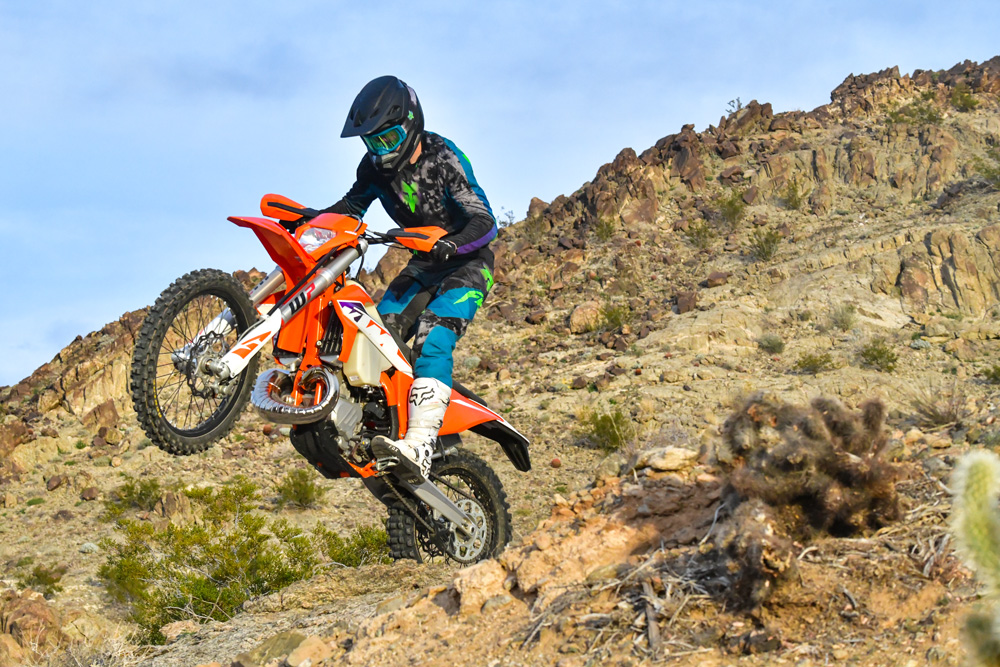 Going into this comparison, we thought the KTM would be tough to beat, and we thought correctly. But the 300 XC-W comes with a premium price tag.
Going into this comparison, we thought the KTM would be tough to beat, and we thought correctly. But the 300 XC-W comes with a premium price tag.
The KTM rated highly in just about every category we could think of. The XC-W does everything well, especially in overall comfort and rideability. As with the other Austrian bikes, we’re fans of its hassle-free oil injection system and ultra-smooth engine. All the bikes have engine counter-balancers and are nearly vibration-free, which used to plague most big-bore two-strokes, but the KTM, for some reason, seems a tick smoother than the rest. It has excellent brakes, plush suspension, and the best ground clearance. Most of us agree that the KTM is the best all-around bike of the group.
Had it not been for its weak brakes, the GasGas might have stolen the title away from the KTM when you factor in price. The GasGas feels a lot like the KTM on the trail, but its lighter flywheel effect gives it a little bit more pizazz, which some of our testers said they really liked.
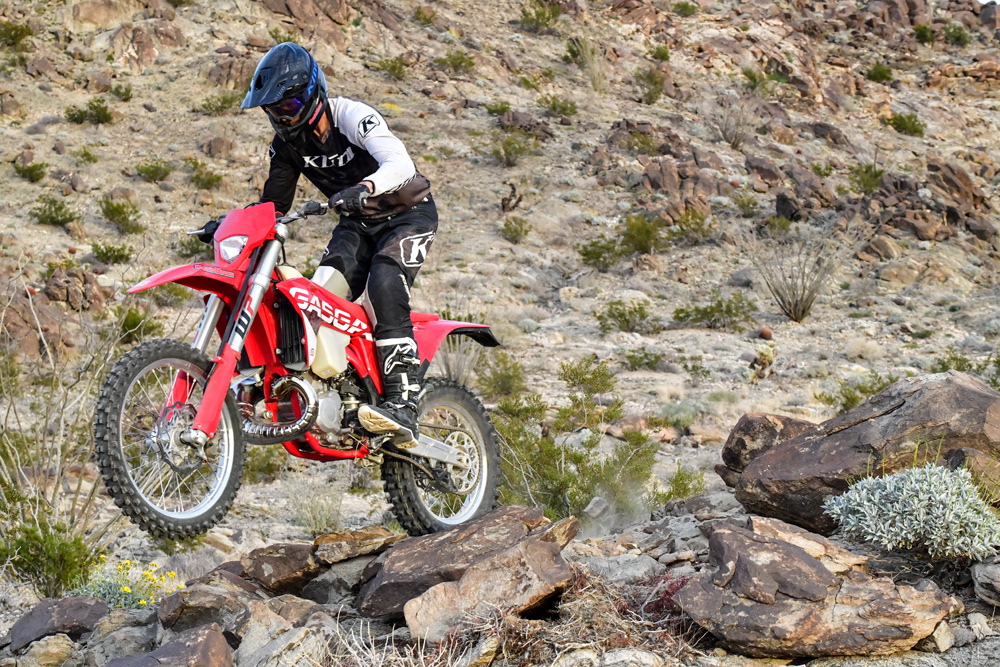 Had it not been for soft brakes, the GasGas EC 300 might’ve taken our Best All-Around Award, especially when you consider it’s the least expensive in this shootout.
Had it not been for soft brakes, the GasGas EC 300 might’ve taken our Best All-Around Award, especially when you consider it’s the least expensive in this shootout.
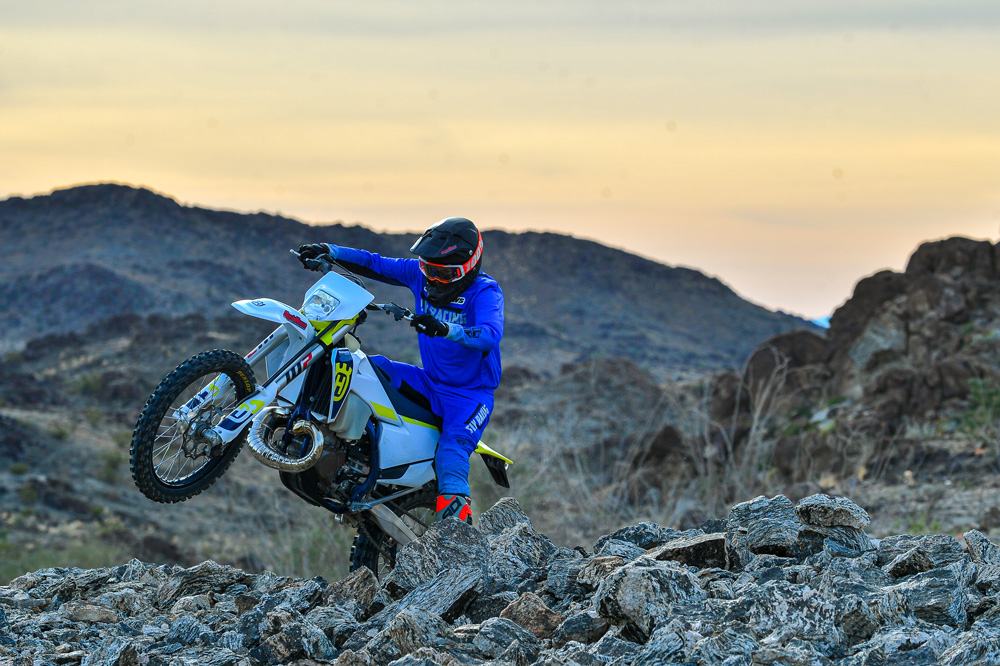 The Husky deserves better binders.
The Husky deserves better binders.
The Husky is right there, too, but its tall handlebar isn’t a hit with our testers. Sure, this is an easy fix, but hey, we ride them how we get them.
The Beta is perhaps the “spiciest” of the group, and if you’re into that, then the Beta is the way to go. It’s full of excitement yet is still a very sound all-around off-roader. Its stout suspension and powerful motor make it the best race bike of the headlight bikes.
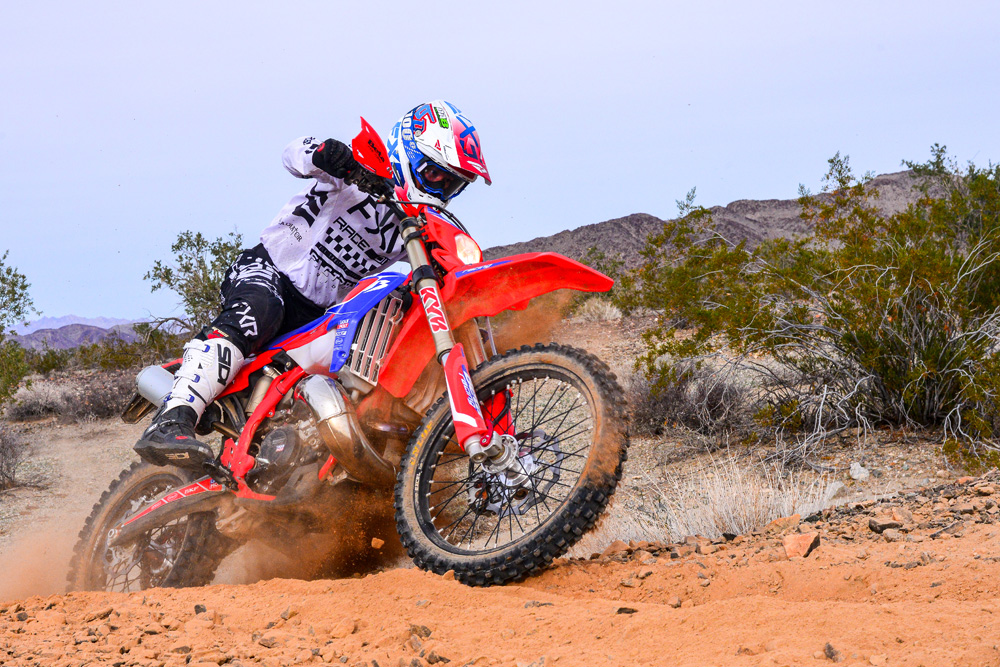 The Beta felt the most “moto-ee.”
The Beta felt the most “moto-ee.”
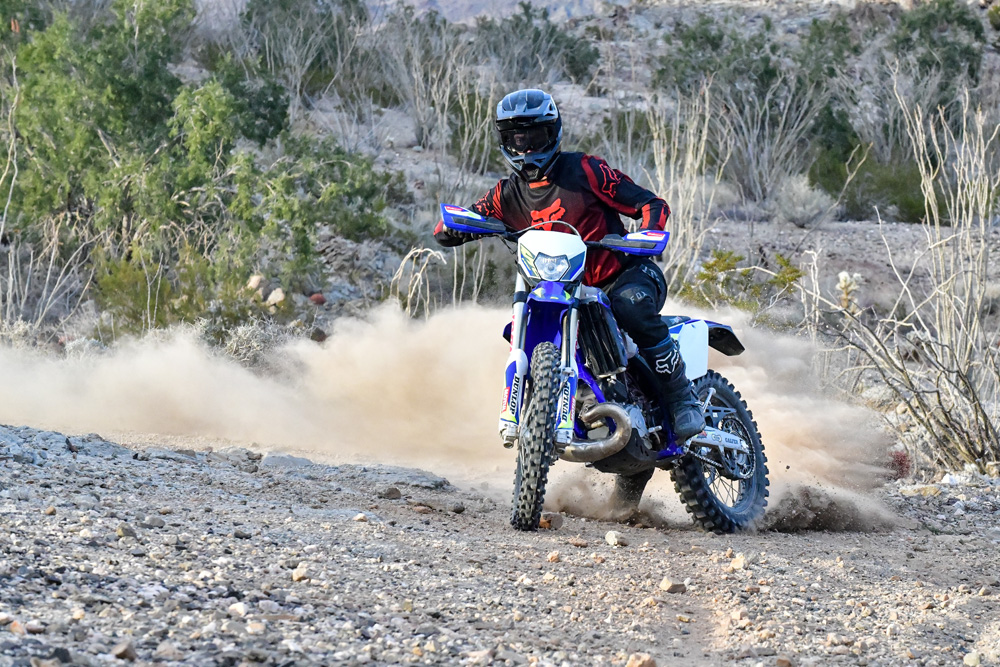 If you like power and lots of torque, you’ll like the French-made Sherco. It’s made to go when the going gets tough.
If you like power and lots of torque, you’ll like the French-made Sherco. It’s made to go when the going gets tough.
The Sherco is a master rock crawler with all the armor to take on the nastiest of trails and live to talk about it. However, it doesn’t seem to fit everyone, and its high-speed ability is a concern.
Bottom line? There are no losers among these five bikes, but after riding them all back-to-back-to-back again and again, we feel the KTM prevails as the best all-arounder for a wide range of off-roaders. But reading through our fireside comments and other analysis here will hopefully help you identify the one that best fits your needs. But don’t be scared to make a bad choice. You really can’t go wrong here. CN
VIDEO | 2023 300cc Two Stroke Off-Road Shootout
2023 300cc 2-Stroke Off-Road Shootout
Off The Record
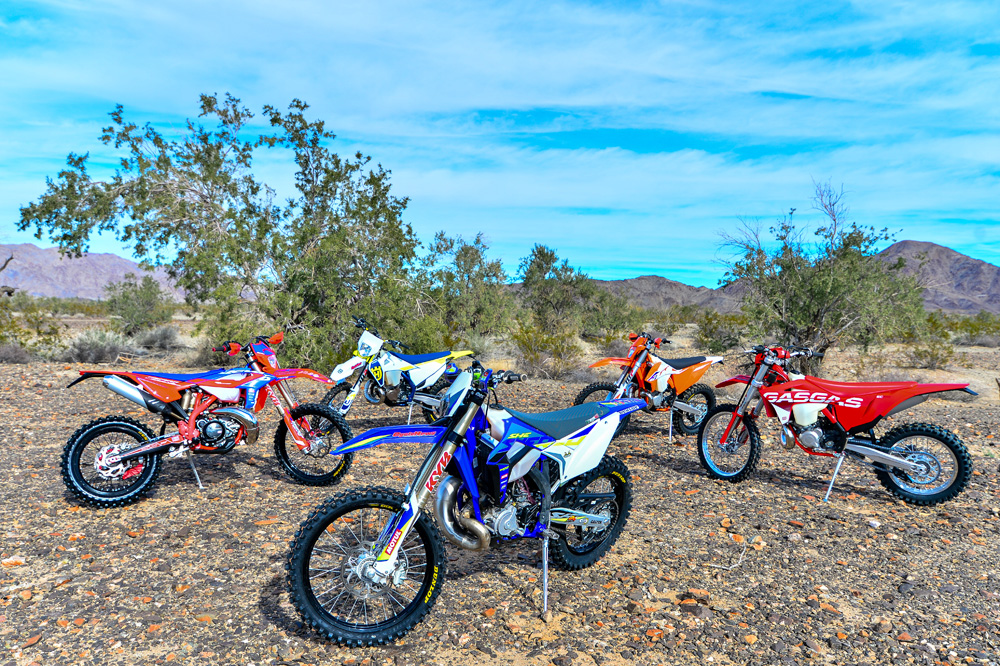
Our two-day test included a camp-out, and many things were said around the campfire that night, supposedly off the record. No such thing! Here are some random quotes from our test riders:
“I just could not get comfortable with the Husqvarna; it is crazy to me that just taller bars made the bike feel so much different than the KTM and GasGas.”
“I felt the most comfortable and capable on [the GasGas and Beta]. For me it came down to the motor, chassis and suspension characteristics of these bikes.”
“The KTM felt the plushest, and I liked the levers, suspension, gas tank width and foot positioning. I correlate this bike feel to a race setup, which is what I’m most comfortable on.”
“Having been on TPI bikes for the past several years, I was stunned at how clean and precise the Beta’s carb was tuned. Throttle response was almost as immediate as the TPI bikes, but with a chunkier, torquey feeling, albeit with a slightly heavier flywheel effect.”
“The Beta’s chassis has a very stable, planted, yet somehow flickable feel to it. It was the most confidence inspiring bike for me while riding our fast, short off-road loop with a mixture of tight rocky singletrack, narrow, rocky sand wash and dry, rutted corners.”
“The GasGas is the most playful of the Austrian bikes.”
“The Sherco has loads of torque down low. Great for tight trail situations and technical riding.”
“The first quality I noticed on the Sherco was the power feel, especially in first gear. Unlike the Austrian bikes, first gear was very useable when riding technical features, which translated to overall bike comfort.”
“With the Beta, I noticed too much engine vibration for my liking. Like the Sherco, though, Beta’s low-end power felt great. It makes me think that both these bikes are built for endurocross.”
“The KTM has the best all-around stock suspension for trail riding.”
“The Husky makes smooth power, making it easy to ride all day.”
“The GasGas’s motor is electric like, smooth bottom end that quickly spins up on demand. Very easy-to-use power.”
